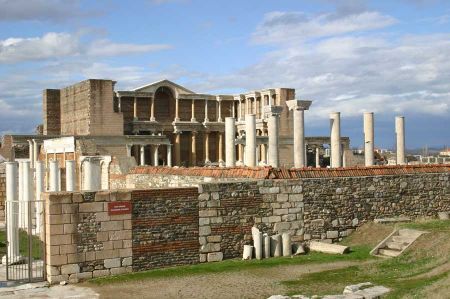Seleucid Empire - successor state to the Alexander Empire
- Written by Portal Editor
The empire of the Seleucids belonged to the so-called Diadoch states, which had been formed after the death of Alexander the Great by dividing the huge empire of Alexander among its former leaders.
It can be said that the Seleucid Empire extended over the entire territory of the perished Persian Achaemenid Empire excluding Egypt. This extensive area comprised the formerly independent cultural areas of Asia Minor, Palestine, Mesopotamia, Babylonia, Media, Persia and Bactria. During the 3rd and 2nd centuries BC, the Seleucid Empire ruled almost the entire Middle East and extended in its greatest extent from European Thrace to the Indus Valley on the territory of today's states Turkey, Syria, Lebanon, Iraq, Kuwait, Iran, Afghanistan, Armenia, Tajikistan, Uzbekistan, Turkmenistan and Israel as well as the Palestinian autonomous regions.
Expansion of the Seleucids and neighboring states
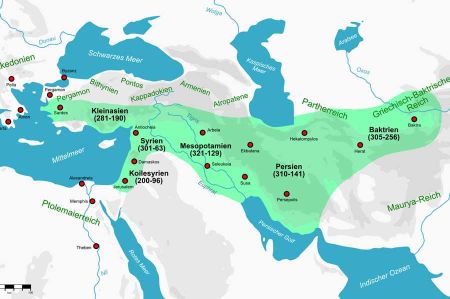 The Seleucids thus became the most powerful successors of the Achaemenids who had ruled in this area in the two centuries before Alexander. The name of the dynasty is derived from its founder Seleukos I Nikator, who started dating from 320 BC. in the Asian satrapies (provinces) of the Alexander Empire as king. In Western historiography, the Seleucids appear on one hand as opponents of Rome during the Roman-Syrian War (192-188) under Antiochus III. the Great in appearance, on the other hand as a foreign ruler during the Jewish Maccabees uprising in the years 167–142 BC.
The Seleucids thus became the most powerful successors of the Achaemenids who had ruled in this area in the two centuries before Alexander. The name of the dynasty is derived from its founder Seleukos I Nikator, who started dating from 320 BC. in the Asian satrapies (provinces) of the Alexander Empire as king. In Western historiography, the Seleucids appear on one hand as opponents of Rome during the Roman-Syrian War (192-188) under Antiochus III. the Great in appearance, on the other hand as a foreign ruler during the Jewish Maccabees uprising in the years 167–142 BC.
In the west, the Seleucid Empire bordered the Greek motherland and the Macedonian Antigonid dynasty. In the northwest lay the smaller empires of Pergamon, Bithynia, Galatia, Pontus, Cappadocia, Armenia and Atropatene, in the northeast the areas of the nomadic Parthians and the Greco-Bactrian Empire, in the east the Indian Maurya Empire. In the southeast the Seleucids were bounded by the Persian Gulf, in the southwest by the Arabian Nefud desert and the Egyptian Ptolemy dynasty.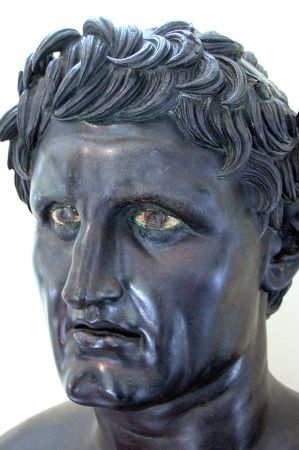 In view of its size, the Seleucid kings did not administer their empire centrally, but instead developed various political priorities for their rule. The most important was in northern Syria, which had existed since 301 BC. as part of the empire. The kings used to stay here in peacetime. Syria had previously just been a peripheral area of neighboring peoples such as the Hittites or Assyrians and was influenced more than the other regions by the Seleucids. They founded several cities in Syria where Greeks were settled. The heart of the country formed the so-called Tetrapolis, which consisted of the four cities Antiocheia on the Orontes, Seleukeia in Pierien, Laodikeia on the sea and Apamea on the Orontes. The southern part of Syria, with today's capital Damascos, belonged to the Ptolemies for a long time and did not belong to the Seleucid Empire until 200 BC. As Koile Syria, this prosperous area was usually combined with Phenicia and Palestine to form a political unit. Towards the end of the Seleucid rule in 63 BC. Their entire territory was limited to Syria.
In view of its size, the Seleucid kings did not administer their empire centrally, but instead developed various political priorities for their rule. The most important was in northern Syria, which had existed since 301 BC. as part of the empire. The kings used to stay here in peacetime. Syria had previously just been a peripheral area of neighboring peoples such as the Hittites or Assyrians and was influenced more than the other regions by the Seleucids. They founded several cities in Syria where Greeks were settled. The heart of the country formed the so-called Tetrapolis, which consisted of the four cities Antiocheia on the Orontes, Seleukeia in Pierien, Laodikeia on the sea and Apamea on the Orontes. The southern part of Syria, with today's capital Damascos, belonged to the Ptolemies for a long time and did not belong to the Seleucid Empire until 200 BC. As Koile Syria, this prosperous area was usually combined with Phenicia and Palestine to form a political unit. Towards the end of the Seleucid rule in 63 BC. Their entire territory was limited to Syria.
Mesopotamia of great importance to the Seleucids
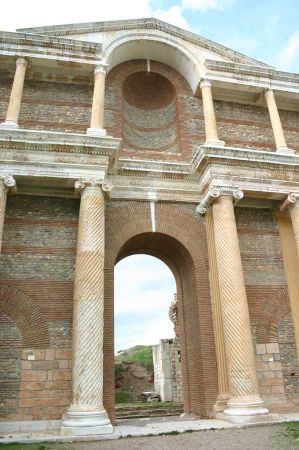 The Mesopotamian region, which was made up of the two wealthy satrapies Mesopotamia and Babylonia, was of enormous economic importance for the empire. Even before the conquest of Syria, 320 and 312 BC were used here. The foundations of the Seleucid Empire was established. Mesopotamia was crossed by numerous Greek colonies, of which Seleukeia on the Tigris served as the capital of the east. After the final defeat against the Parthians in 129 BC. BC the area was lost to the Seleucids, which also meant the end of their great power position.
The Mesopotamian region, which was made up of the two wealthy satrapies Mesopotamia and Babylonia, was of enormous economic importance for the empire. Even before the conquest of Syria, 320 and 312 BC were used here. The foundations of the Seleucid Empire was established. Mesopotamia was crossed by numerous Greek colonies, of which Seleukeia on the Tigris served as the capital of the east. After the final defeat against the Parthians in 129 BC. BC the area was lost to the Seleucids, which also meant the end of their great power position.
The third focus of Seleucid power was in Sardis in western Asia Minor, where the dynasty 281 BC. could gain a foothold. We had several opportunities to visit the ruins of the former capital Sardis. However, since all the important Diadochian states made claims to the predominantly Greek-populated peninsula, the Seleucids were never able to fully assert themselves here. Their possessions were usually limited to Cilicia bordering Syria and the inland areas of Ionia and Phrygia. Nevertheless, the dynasty regularly tried to gain a foothold in the coastal regions and in Thrace, which is located in Europe. After the defeat by the Roman Empire in 188 BC. however, only Cilicia remained to the Seleucids until the Tauros.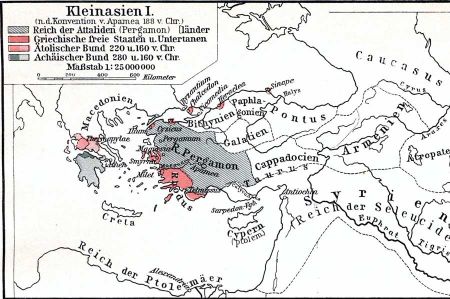 In western Iran, the Seleucids were able to establish themselves as the successors of the Achaemenids. Since 310 BC Media, Susiane, Persis and Karmanien belonged to the empire. The Seleucid kings regularly married into Iranian rulers in order to preserve their legitimacy. A comprehensive colonization of the country with Greeks did not take place in contrast to the other important parts of the empire. In 141 BC the Parthians conquered Iran.
In western Iran, the Seleucids were able to establish themselves as the successors of the Achaemenids. Since 310 BC Media, Susiane, Persis and Karmanien belonged to the empire. The Seleucid kings regularly married into Iranian rulers in order to preserve their legitimacy. A comprehensive colonization of the country with Greeks did not take place in contrast to the other important parts of the empire. In 141 BC the Parthians conquered Iran.
During the early phase of the Seleucid Empire, this comprised from 305 BC onwards. Also the eastern Iranian highlands and the Hindu Kush. The satrapies Parthia and Bactria established there, however, made their way independent around 256 BC. Although nominally they remained Seleucid vassals for a long time, they were never administered directly. Two important empires emerged from Parthia and Bactria, which later extended to Mesopotamia and India, respectively.
In the east, Bactria bordered the Maurya Empire under leader Ashoka. The son of Bindusara sought friendly relations with his neighbors such as the Seleucids and the Greeks in Bactria.
After several generations of decline into a small Syrian state, the Seleucid Empire ended when the Roman general Pompey in 63 BC. deposed the last Seleucid king. To the west of the Euphrates, Rome became the successor of the Seleucids, to the east of it the Parthian Empire.
Please also read:
The imposing Artemis Temple near Sardis
Sardis on Mount Timulus - ancient city with flair
